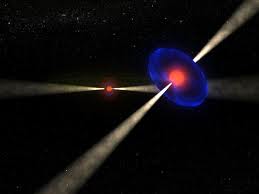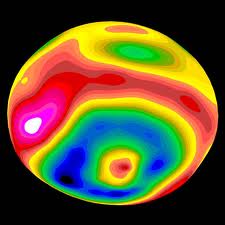
 Eclipsing Pulsar Promises Clues to Crushed Matter
Eclipsing Pulsar Promises Clues to Crushed Matter
A city-sized sphere rotating 518 times a second…
Astronomers using an X-ray telescope in space have found the first fast X-ray pulsar to be eclipsed by its companion star. Further studies of this unique double-star system will shed light on some of the most compressed matter in the universe.
The pulsar is a rapidly spinning neutron star—the crushed core of a massive star that long ago exploded as a supernova. Neutron stars, in which matter exists only in the form of neutrons, pack more than the Sun’s mass into a ball nearly 60,000 times smaller. With estimated sizes between 10 and 15 miles across, a neutron star would just span Manhattan or the District of Columbia.
The neutron star is called a pulsar because it produces fast X-ray pulses that can be detected by an X-ray telescope from space. How fast? Imagine a star spinning 518 times a second—that’s a city-sized sphere rotating as fast as the blades of a kitchen blender.
Known as J1749, the system erupted with an X-ray outburst on April 10. During the event, NASA’s Rossi X-ray Timing Explorer (RXTE) orbiting telescope observed three “eclipses” of the neutron star by its companion; detected X-ray pulses that identified the neutron star as a pulsar; and even recorded pulse variations that indicated the neutron star’s orbital motion.
J1749 was discovered in June 2006, when a smaller eruption of X-rays brought it to the attention of NASA’s Swift satellite. Observations by Swift, RXTE, and other spacecraft revealed that the source of the X-rays was a binary system located 22,000 light-years away in the constellation Sagittarius—and that the neutron star was actively capturing, or accreting, gas from its stellar partner. This gas gathers into a disk around the neutron star.
“Like many accreting binary systems, J1749 undergoes outbursts when instabilities in the accretion disk allow some of the gas to crash onto the neutron star,” said Tod Strohmayer, RXTE’s project scientist at NASA’s Goddard Space Flight Center in Greenbelt, Md.
When gas falls to the pulsar’s’s surface, its powerful magnetic field directs the infalling gas onto the star’s magnetic poles. This means that the energy release occurs in hot spots that rotate with the neutron star, producing the fast X-ray pulses.
In addition, the pulsar’s orbital motion imparts small but regular changes in the frequency of the X-ray pulses. These changes show that the two stars in this system revolve around each other every 8.8 hours.
During the week-long outburst, RXTE observed three periods when J1749’s X-ray emission briefly disappeared. These eclipses, which lasts 36 minutes each, occur whenever the neutron star passes behind the normal star in the system.
Writing about their findings in the July 10 issue of The Astrophysical Journal Letters, Markwardt and Strohmayer note that they have all but one orbital variable needed to nail down the mass of the pulsar, which is estimated to be between about 1.4 and 2.2 times the Sun’s mass.
“We need to detect the normal star in the system with optical or infrared telescopes,” Strohmayer said. “Then we can measure its motion and extract the same information about the pulsar that the pulsar’s motion told us about the star.”
Images:
http://www.nasa.gov/topics/universe/features/eclipsing-pulsar.html
http://imagine.gsfc.nasa.gov/docs/science/know_l1/pulsars.html
You can contact Bob Eklund at [email protected], or visit his website at www.bobeklund.com.





Be the first to comment